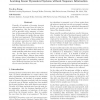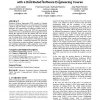420 search results - page 27 / 84 » Modeling Herds and Their Evolvements from Trajectory Data |
TMI
2010
13 years 3 months ago
2010
As decisions in cardiology increasingly rely on non-invasive methods, fast and precise image processing tools have become a crucial component of the analysis workflow. To the best ...
ICDE
2007
IEEE
14 years 3 months ago
2007
IEEE
Moving objects databases (MOD) have been receiving increasing attention from the database community in recent years, mainly due to the wide variety of applications that technology...
ICML
2009
IEEE
14 years 3 months ago
2009
IEEE
Virtually all methods of learning dynamic systems from data start from the same basic assumption: that the learning algorithm will be provided with a sequence, or trajectory, of d...
CVPR
2009
IEEE
15 years 3 months ago
2009
IEEE
We present a system for the estimation of unconstrained
3D human upper body movement from multiple cameras.
Its main novelty lies in the integration of three components:
single-...
ICSE
2008
IEEE-ACM
14 years 9 months ago
2008
IEEE-ACM
Distributed Software Engineering (DSE) concepts in Computer Science (or Engineering) Degrees are commonly introduced using a hands-on approach mainly consisting of teaching a part...


